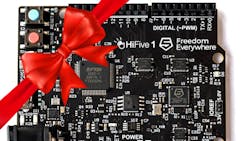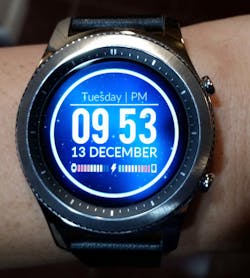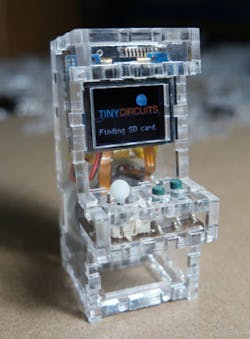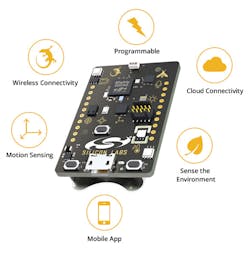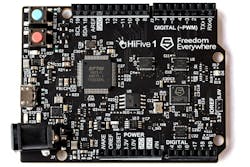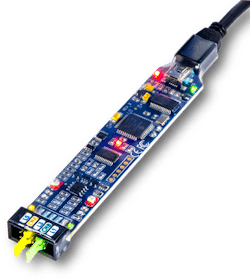Finding a present for the technologically inclined can sometimes be tough if they already have the latest smartphone, quadcopter, or 3D virtual reality goggles. So if you are looking for something different, here are a few ideas that I have actually tried out.
Smartwatches
I recently had to return my Basis smartwatch before it decided to burn me. Luckily they did give a refund, because I like the watch. I spent a while looking for a new one and waited until the Samsung Gear S3 showed up (Fig. 1). And I’m glad I did.
The S3 has some features I was looking for. The four-day battery operation (yes, I have run it that long) was a major plus, along with a great screen without a flat tire (the small part at the bottom that is missing on some smartwatches like the Motorola Moto 360). The watch has Bluetooth and Wi-Fi so it can be linked to my phone when it is sitting in the charge in another part of the house, where it often sits when I am at home.
The S3 is also a speakerphone, which was one of the main features I wanted. It works great, and it means I don’t have to attempt to pull my phone out of my pocket when it rings. It is very handy for checking and getting event notifications.
There is a downside to the S3 compared to Android and Apple solutions: the number and functionality (but not the quality) of apps and widgets available. Worse, it is very hard to find them, given Samsung’s rather poor app store. It is annoying not to be able to see just a list of apps for the S3, possibly because the list would not be long. That said, I have only added a couple extra apps, and I would still choose the S3 over the competition…for now.
TinyCircuits’ Tiny Arcade (Fig. 2) highlights its array of postage stamp-sized boards, ideal for building or prototyping the next great Internet of Things (IoT) device. The Tiny Arcade uses a few of those boards, including a tiny display that has a playable gaming machine—albeit one for very tiny fingers. It comes unassembled. You can always disassemble it when you get bored and turn it into a robot controller for your idle Roomba.
If an arcade machine is not of interest and the S3 is a bit too expensive, try out NXP’s Hexiwear. It can be used as a smartwatch with Bluetooth and a heart rate monitor. It is definitely not as slick as the S3, but it is designed to be hackable.
For those interested in more conventional modules, take a look at Silicon Labs’ Thunderboard Sense (Fig. 3). I like this platform because it was easy to connect to the cloud and has a conventional development tools collection I already had on hand, so it was easy to work with—at least for me.
Any of these are suitable for prototyping IoT applications.
RISC-V Micro
Okay, I haven’t played with SiFive’s HiFive1 (Fig. 4) with the Freedom E310 microprocessor, but I have used RISC-V on a simulator. I was going to drop it onto a Microsemi FPGA, but I’ve decided to wait on that; the company’s sending a new FPGA board to look at that is specifically set up for RISC-V. I’ll let you know how that works when it arrives.
The HiFive1 will likely be the present to myself, since they are just now becoming available. It is the first generally available chip with the RISC-V instruction set architecture (ISA). Keep in mind that RISC-V is an ISA and not actually a platform like ARM’s Cortex families. RISC-V is comparable to the ARM ISAs.
I have had a chance to play with RISC platforms and you can get MIPS micros from Microchip. They are quite impressive and offer many of the advantages that RISC-V does. Still, RISC-V is the new kid on the block, and something every embedded geek wants to try out.
USB Scope and Logic Analyzer
Not all of us have a real scope or logic analyzer on our desk, but they are indispensable when working with electronics. If you don’t want to break the bank but need a way to divine what those bits and electrons are doing, check out a Bitscope (Fig. 5). These USB-based scopes and logic analyzers even work with platforms ranging from PCs to Raspberry Pis.
I really like the protocol support on the logic analyzer. It is handy for tracking what is going out the I2C or SPI port to the peripheral boards connected to the HiFive1 or Hexiwear breakout board. I would go into more of the features, but that would make this article a lot longer.
SPARK 2014 Toolset
It is always nice to give something that is good for you, so here is my suggestion (and it’s a cheap one): Learn SPARK. Yes, I mean that Ada programming language subset. Given the importance of safety and security with your latest IoT project, it is also a great way to program ARM Cortex-M chips, as well as everything else up to systems flying aircraft.
Free tools are available from a number of sources, including Adacore’s Libre site. They also have free online courseware at Adacore University.
I only program personal projects these days, and right now it’s split between SPARK and PHP. Still, check out some feedback from a new C-turned-Ada programmer.
Okay, this may be an eclectic list, but hopefully there’s something in here that piqued your interest for gift-giving. Let me know if you have any new favorites. Keep it techy.
About the Author
William Wong Blog
Senior Content Director
Bill's latest articles are listed on this author page, William G. Wong.
Bill Wong covers Digital, Embedded, Systems and Software topics at Electronic Design. He writes a number of columns, including Lab Bench and alt.embedded, plus Bill's Workbench hands-on column. Bill is a Georgia Tech alumni with a B.S in Electrical Engineering and a master's degree in computer science for Rutgers, The State University of New Jersey.
He has written a dozen books and was the first Director of PC Labs at PC Magazine. He has worked in the computer and publication industry for almost 40 years and has been with Electronic Design since 2000. He helps run the Mercer Science and Engineering Fair in Mercer County, NJ.
- Check out more articles by Bill Wong on Electronic Design
- Bill Wong on Facebook
- @AltEmbedded on Twitter
